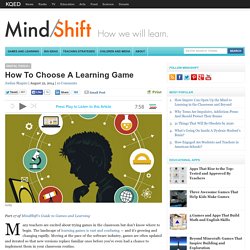

8 Principles of Productive Gamification - Getting Smart by Tom Vander Ark - blended learning, CCSS, common core, Innovation. Using games to promote learning isn’t a new idea.

But the widespread use of game-based adaptive learning systems, the explosion of mobile learning applications, and the growing use of game-based strategies makes gamification one of the most important education trends of this decade. According to Teachers College, gamification is the use of game mechanics and dynamics like badges, leaderboards, and actions to improve motivation and learning in informal and formal settings. Ranging from occasional mobile game play, to scheduled weekly time in an adaptive system, to an entire school like Quest to Learn organized around gamification principles, it’s likely that games and/or gamification are part of the learning experience for most U.S. K-12 students. Leaderboards: Learning Lessons From Research & Gamification. This is the 4th in a series on the use of leaderboards and other strategies to encourage students to reflect on their performance.

Do we face “A future where everything we do is tracked and quantified: calories, air quality, sleep, heart rate, microbes, brain waves, finances, happiness, sadness…hopes and dreams?” Rose Eveleth, a podcaster that focuses on future scenarios and planning, explored the future of the quantified self in a recent podcast. Gamification Successes and Failures in Higher Education. By Bob Hand Gamification has become an increasingly pervasive part of education over the last decade.

Educators in K-12 schools have found creative ways to engage students by gamifying coursework. But why are these teaching strategies not more common in higher education? Gamification, the process of introducing elements and mechanics from games into the classroom, can often be dismissed as just a buzzword in HigherEd. 9 Things That Educators Should Know About Gamification - The Tech Edvocate. Higher Education Research. How to Gamify Your Classroom – The Tech Edvocate. Black Menu for Google. Digital Game Based Learning in Higher Ed Moves Beyond the Hype. How To Choose A Learning Game. Getty Part 17 of MindShift’s Guide to Games and Learning Many teachers are excited about trying games in the classroom but don’t know where to begin.

The landscape of learning games is vast and confusing — and it’s growing and changing rapidly. Moving at the pace of the software industry, games are often updated and iterated so that new versions replace familiar ones before you’ve even had a chance to implement them in your classroom routine. And teachers have busy schedules. On the other hand, not exploring, updating and reinventing our teaching strategies can cause us to miss valuable opportunities to reach students. Is It Fun? Selecting the right game can be like walking the teachers’ tightrope. This is the same tension an English teacher might be forced to mediate when picking a text. Cool and fun are not the same thing.
Think about games the same way. The Mechanics Matter Most The best learning games are always fun. Are You Comfortable? Digital Game Based Learning in Higher Ed Moves Beyond the Hype. Beyond K-12: 8 Reasons Why Higher Education Should Adopt Gamification. Gamification has been part of teaching strategy in K-12 even before it was common for computers to exist in the classroom.

Teachers have used games for decades to keep students engaged in the learning process, to make instruction easier to digest for students with varying learning styles, to get an idea of how students are doing that may not be reflected in test scores, and to boost morale in the classroom. Today, the things that are being done in the K-12 setting are often rather remarkable.
Gamification in eLearning Facts Infographic. Game-Based Learning: Is It the Future of Education? About ETR Community.

How to Gamify Your Life to Quickly Accomplish Big Goals – Medium. Is your life a video game, filled with challenging quests and new adventures?

Or has your life become somewhat stale? As most people get older, they lose their childhood sense of wonderment and openness. Most people stop growing and settle for “reality” as they see it. But life doesn’t have to suck. Growth doesn’t have to be slow. Your life can become like a game where you pursue greater obstacles, learn new skills, and have thrilling experiences. This article details a few strategies you can use to gamify your life. Compete with Those Way Ahead of You “It is the most closely-allied forms, varieties of the same species, and species of the same genus or of related genera, which, from having nearly the same structure, constitution, and habits, generally come into the severest competition with each other.” — Charles Darwin What Darwin is explaining is that all forms of life compete with those most closely related.
It would make little sense for a painter to compete with a rock-climber. 1. 2. 8 Research Findings Supporting the Benefits of Gamification in Education. On Sunday, Tess Pajaron sent me a great article from Open Colleges about “The Virtues of Daydreaming And 30 Other Surprising (And Controversial) Research Findings About How Students Learn”.

One thing that really struck me about this article is how many of these findings indicated benefits that can come from the use of gaming in education. Some of the findings directly addressed the subject, while others were indirectly indicative of potential positive outcomes of gaming in an instructional context. Introducing a Game-Based Curriculum in Higher Ed. Continuing from last week’s post about “The Gamification of Education”, this week we bring you a guest post from Justin Marquis, who examines the why’s and how’s of incorporating game based learning elements into the higher education curriculum.

5 Ways Gamification Can Help Students Develop A Growth Mindset. Gamification allows us to enhance our knowledge and enhance our basic soft skills like multi-tasking, collaborating, creative thinking and committing to a goal.

In 2002, the word gamification was coined as a way to describe the incorporation of game-thinking and game-mechanisms to solve real world problems. Companies like Duolingo, the second language learning app, turned learning language into a competition amongst friends and strangers. 5 Video Game Principles that Motivate Endless Play and Learning. Everyone is well aware that video games captivate audiences around the world. By 2015, their annual market share is projected to be $111 billion.
If we can understand what makes video games so engaging (their core principles, not superficial mechanics), we can harness these principles to make our schools more effective.